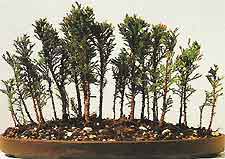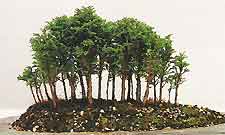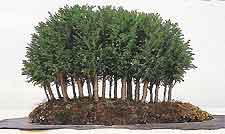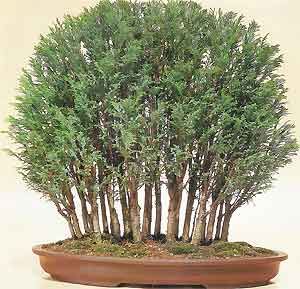Bonsai Trees
Case Histories
False Cypress - (chamaecyparis lawsoniana ellwoodii)
Cypress Bonsai Style: Group Planting

One day many years ago I noticed a neighbour pruning a specimen dwarf cypress which was growing in his front garden. I asked if I could have one of the branches that had been removed, so that I could take some cuttings.
Being late winter I was not sure if they would root, but did not want to miss out on this opportunity to propagate new stock, especially as I had been planning a group planting and these could possibly be utilised for this.

From the one branch I was able to take almost thirty separate cuttings of different sizes and these were inserted into a gritty soil mix in a small seed tray. Later that year they were all still alive and showing signs of life. I had certainly hoped that a few would root, but did not expect all of them to be successful and was suitably pleased with myself.
Cypress Bonsai History: Training
The cuttings remained in the seed tray for two more years, where they established good root systems. With so many small cypress trees now available, a group planting was certainly possible and a bonsai pot was selected and used.

During their first year they quickly outgrew the pot and I searched for a more natural solution. I obtained an old rectangular slate roof tile at a reclamation yard and using a large pair of pliers, carefully shaped the edges to create the look of a piece of slate collected from a quarry.
The next year I removed the group from its pot and the root mass was dense with fine roots. I then proceeded as if it were a single tree, lightly root pruning. Small holes were drilled in the centre of the slate to provide drainage and enable the group to be secured with wire ties.
For the next five years the group was allowed to extend slowly, with constant pinching. The trees at the sides and back were trimmed harder, so that they would remain smaller than the rest, creating a feeling of depth.

Conversely, several of the trees nearer the front were not pruned at all for two years, so that they would grow larger than the rest in order to further enhance the perspective. Over the next few years the trees began to form a unity. They were regularly thinned out so that the trunks remained slender and did not become too thick, which would have spoilt the desired effect, a group of tall trees.
The group was now root bound and it became difficult for water to penetrate the mass of roots. I therefore regularly submersed the group in a large container full of water. This I found to be effective, but tiresome. In the meantime the group was beginning to outgrow the slate and it was time to find a large pot! I had several spare shallow pots and placed the group in each one to see which was most suitable. It was clear that a large oval pot was very appropriate and in spring the group was root pruned and planted in this pot.
This method has proved an easy way of establishing a realistic group planting from very humble beginnings. The trees look good all year round and are always undemanding. It gives me a great deal of satisfaction when I view my group of twenty nine trees, that the only cost to date has been the price of the pot they are now growing in.
 One day many years ago I noticed a neighbour pruning a specimen dwarf cypress which was growing in his front garden. I asked if I could have one of the branches that had been removed, so that I could take some cuttings.
One day many years ago I noticed a neighbour pruning a specimen dwarf cypress which was growing in his front garden. I asked if I could have one of the branches that had been removed, so that I could take some cuttings. From the one branch I was able to take almost thirty separate cuttings of different sizes and these were inserted into a gritty soil mix in a small seed tray. Later that year they were all still alive and showing signs of life. I had certainly hoped that a few would root, but did not expect all of them to be successful and was suitably pleased with myself.
From the one branch I was able to take almost thirty separate cuttings of different sizes and these were inserted into a gritty soil mix in a small seed tray. Later that year they were all still alive and showing signs of life. I had certainly hoped that a few would root, but did not expect all of them to be successful and was suitably pleased with myself. During their first year they quickly outgrew the pot and I searched for a more natural solution. I obtained an old rectangular slate roof tile at a reclamation yard and using a large pair of pliers, carefully shaped the edges to create the look of a piece of slate collected from a quarry.
During their first year they quickly outgrew the pot and I searched for a more natural solution. I obtained an old rectangular slate roof tile at a reclamation yard and using a large pair of pliers, carefully shaped the edges to create the look of a piece of slate collected from a quarry. Conversely, several of the trees nearer the front were not pruned at all for two years, so that they would grow larger than the rest in order to further enhance the perspective. Over the next few years the trees began to form a unity. They were regularly thinned out so that the trunks remained slender and did not become too thick, which would have spoilt the desired effect, a group of tall trees.
Conversely, several of the trees nearer the front were not pruned at all for two years, so that they would grow larger than the rest in order to further enhance the perspective. Over the next few years the trees began to form a unity. They were regularly thinned out so that the trunks remained slender and did not become too thick, which would have spoilt the desired effect, a group of tall trees.